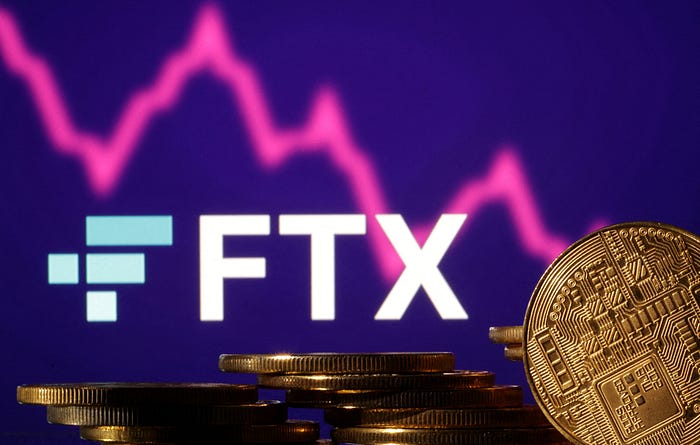The Hidden Depths of the FTX Catastrophe
Written on
Chapter 1: The Rise of Sam Bankman-Fried
The story of FTX begins with its 30-year-old CEO, Sam Bankman-Fried, who once boasted a staggering net worth of $26 billion. With connections to influential figures like Steph Curry, Jeff Bezos, and Leonardo DiCaprio, he seemed to be the epitome of success. Major investors, including BlackRock and SoftBank, placed their trust in his vision. However, beneath this glamorous exterior lay a troubling truth: Sam's empire was largely run by a small group of young associates engaged in romantic entanglements, operating from the Bahamas.
Former colleagues would play pivotal roles in the subsequent downfall. Sam was an advocate for effective altruism, a philosophy aimed at maximizing positive global impact. His inner circle consisted of ten housemates who not only partied together but were also romantically involved. This included Caroline Ellison, the inexperienced CEO who openly discussed her use of amphetamines.
Section 1.1: The Birth of FTX
Sam's next venture was FTX, a cryptocurrency derivatives exchange. For those unfamiliar, an exchange is a platform where users can trade various cryptocurrencies and tokens, typically for a fee. Unbeknownst to higher management, this group of misfits kept them in the dark about their activities. According to a former employee, they were "just a bunch of degenerate kids."
Subsection 1.1.1: FTX's Ambitious Growth

Sam succeeded in raising $2 billion from hedge funds and investment banks, claiming that he wanted to create a platform that catered to more experienced investors. FTX distinguished itself by offering advanced financial products, such as options trading and tokenized stocks.
As FTX expanded, it became a household name, featuring endorsements from celebrities like Tom Brady, Stephen Curry, Naomi Osaka, and Larry David. By July 2021, FTX was reportedly handling $10 billion in trading volume daily across its million users. The exchange even played a geopolitical role, partnering with the World Economic Forum and aiding Ukraine.
Section 1.2: The Catalyst for Collapse
The turning point came when Changpeng Zhao, known as CZ, CEO of Binance—FTX's main competitor—made a single tweet that triggered a chain reaction, leading to FTX's downfall. CZ's political donations, amounting to $23 million to Republican politicians, were part of his strategy to gain leverage against FTX.
As the cryptocurrency market began to decline, Sam Bankman-Fried emerged as a stabilizing figure, offering loans comprised of both cryptocurrency and cash. However, he secretly moved at least $4 billion in consumer funds, publicly claiming these transactions were merely internal transfers.
Chapter 2: The Unraveling of FTX
The first video titled "The FTX Disaster is Deeper Than You Think" explores the complexities behind FTX's rise and fall, highlighting key figures and decisions that led to the collapse.
As accusations began to surface about Alameda Research, the situation quickly escalated. Sam manipulated a coin's value to use it as collateral for financing, which he believed would remain unproblematic as long as the coin's value increased. Unfortunately for Sam, the opposite occurred, and as the allegations mounted, he faced a significant backlash.
The second video, "The FTX Disaster is Deeper Than You Think," delves deeper into the ramifications of Sam's actions and the broader implications for the cryptocurrency market.
In an attempt to reassure the public, Sam took to Twitter, claiming the company's assets were stable. However, the reality was dire, with reports indicating an $8 billion shortfall between assets and liabilities. The situation worsened as $150 billion was wiped from the market value of the top 15 cryptocurrencies in just three days.
FTX, once valued at $32 billion, was now in ruins. Over $1 billion of customer cryptocurrency had vanished, with $1 to $2 billion unaccounted for after being transferred to Alameda. As Sam's wealth evaporated, he found himself under police surveillance in the Bahamas and was later arrested and extradited to the United States.
The prevailing theory suggests that the missing funds were siphoned through an insider's secret backdoor, with Sam's nonchalant response to inquiries about the missing funds raising further suspicions. As authorities discussed his extradition, it became clear that the political implications of his donations would also come into play.
The parallels between the FTX disaster and the 2008 financial crisis are striking. Both scenarios involved entities creating risky financial products and passing the consequences onto others, highlighting that even in a decentralized world, bad actors can exploit opportunities for profit. Having recently watched a documentary on the 2008 crisis, I can't help but see the connections. For those interested, I will include links to documentaries on fraud and scams, including Theranos, Enron, Worldcom, Onecoin, and Luna below.
Find out more about Coldfusion here. Please like, comment, and subscribe to show your support.